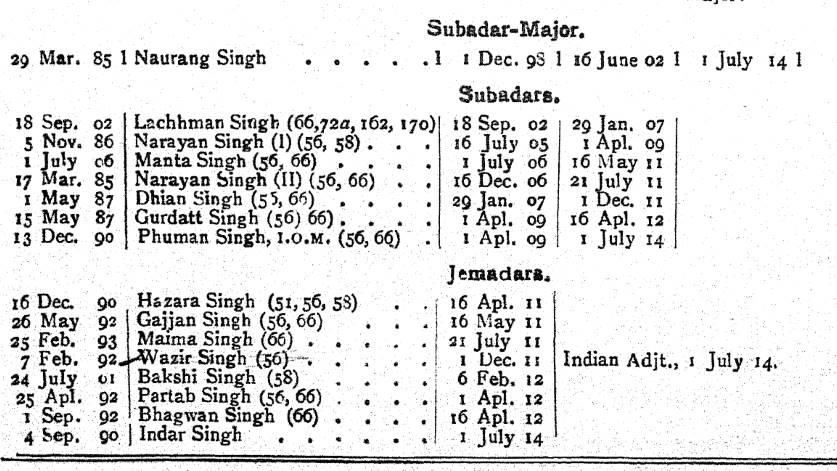This article is about the 15th Ludhiana Sikhs and will help you to research the Regiment and the soldiers who served with it during the First World War. I have written a separate article for the war-raised 2nd Battalion 15th Ludhiana Sikhs and a series of guides to help you to research soldiers who served in the Indian Army during the war. To view the guides click on the blue links below:
The 15th Ludhiana Sikhs in the First World War
Lineage: Raised by Major P. Gordon at Ludhiana as the Regiment of Ludhiana in 1846. The designation became 16th Regiment of Bengal Native Infantry in 1861 and the same year the 15th Bengal Native Infantry and the 15th (Ludhiana) Regiment of Bengal Native Infantry in 1864. The 15th Regiment of Bengal Native Infantry (Ludhiana Sikhs) in 1885 and the 15th (Ludhiana) Sikh Infantry in 1901. In 1903 it became the 15th Ludhiana Sikhs and the 2nd Battalion (Ludhiana Sikhs) 11th Sikh Regiment in 1922.
Class Composition of Battalion in 1914: 8 Companies Sikhs. 1919: 4 Companies of Sikhs.
Location in 1914: The 15th Sikhs was stationed at Loralai (Balochistan, Pakistan), having arrived from Nowshera (Khyber Pakhtunkhwa, Pakistan) on 5th February 1913.
The 15th Ludhiana Sikhs was stationed at Loralai when the First World War began in August 1914 and received orders to mobilize on 8 August. The Regiment left India at Karachi, now in Pakistan on 29 August and arrived at Marseilles, France on 26 September. The extract below was taken from the October 1914 Indian Army List and records the Indian officers who were serving with the Regiment. The first column was when the officers enlisted in the Indian Army, not necessarily the 15th Sikhs, the second column when they were promoted to Jemadar and the third column when they were promoted to Subadar. Naurang Singh’s third column recorded that he was promoted to Subadar-Major on 1 July 1914. The numbers after the officers’ names recorded courses passed and there is a list of these at the start of the book.

Lieutenant-Colonel Charles Augustus Vivian 15th Ludhiana Sikhs who was killed in action on 27 April 1915. This portrait and a lengthy obituary was published in Bond of Sacrifice.
War Diaries of the 15th Ludhiana Sikhs
There are four war diaries for the Regiment but only the first and last have been digitized. To download these two war diaries for a small fee, click on the blue links below which will take you to the National Archives’ website. The other two war diaries can only be viewed at the National Archives. I have copies of all war diaries and have transcribed some entries below.
- Date: 01 August 1914 – 31 August 1915
- 9th Sirhind Brigade, 3rd (Lahore) Division
- Reference: WO 95/3929/5
- Notes: A superb war diary, containing a wealth of information. Possibly the most detailed war diary of any Indian unit which served in the First World War. Many daily entries are over a hundred words in length and if you only view one Indian war diary this is it. See extracts below.
- Date: 01 September 1915 – 28 February 1916
- Suez Canal Defences
- Reference: WO 95/4428
- Notes:
- Date: 04 May 1919 – 11 September 1919
- 1st Infantry Brigade, 1st Indian Division
- Reference: WO 95/5406
- Notes: A very good war diary with lots of detail and a large number of appendices. There are nominal rolls of British and Indian officers serving with the Regiment in May and September 1919.
- Date: 01 July – 31 December 1920
- 75th Indian Infantry Brigade, 17th Indian Division, Mesopotamia
- Reference: WO 95/5214/3
- Notes: A very detailed war diary which contains an excellent level of detail, with casualties recorded along with their regimental number. British and Indian officers appear throughout and there is a list of British officers with the 15th Sikhs on 1 August 1920. There are no appendices.
Further Sources for the 15th Sikhs
A very good source of information for the Regiment and the British officers who served with it are its confidential reports held at the British Library: Confidential Reports on Regiments etc. These reports also contain the annual reports of the British officers serving with the Regiment. However, when the 15th Sikhs was abroad only its Depot and the British officers serving with it were reported on. For information regarding the British and Indian officers who served with the 15th Sikhs, the Indian Army List should be consulted. I have transcribed a large portion of the 15th Sikhs’ war diary at the bottom of my page on Indian World War One War Diaries. The Regiment qualified for the General Service Medal with Iraq and Kurdistan Clasp and some of their Medal Index Cards have survived. These can be downloaded from the National Archives’ Website but I would recommend viewing them on Ancestry as they are free to view.
If you’d like to learn more about the Indian Army on the Western Front I can recommend Sepoys in the Trenches: The Indian Corps on the Western Front 1914-15 by Gordon Corrigan.
Extracts from War Diaries of the 15th Sikhs
01 August 1914 – 31 August 1915, WO 95/3929/5
8 June 1915 – A telescopic rifle has been lent us by the 4th Kings, and also a rifle to which is fitted a periscope by means of which the rifle can be fired over the parapet the firer remaining under cover, this has been most urgently needed ever since the commencement of operations and yet simple as it is has taken 8 months to arrive and when it does do so there is only one whereas there ought to be one at least per platoon.
10 June 1915 – Weather still remains very misty impending any observation of enemies lines; their loop holes are most difficult to locate as they use every kind of coloured sandbags from white to black.
12 June 1915 – At 5pm yesterday evening the enemy commenced his “frightfulness” or evening hate with salvos of pipsqueaks and heavy howitzers and all night long he kept up a most vigorous fire in bursts rendering all work almost impossible, at 2.20 am he started throwing some 30lb bombs over the firing line and supports without effect except for making a lot of noise and waking everyone from their sleep, the whole night also he threw up a large number of flares almost vertically which seemed to point to a new regiment having come into the firing line opposite us with very little training.
As dawn broke he quieted down and the day passed fairly quietly had the reliefs taken place last night as it was originally intended they would either have been held up or would have suffered very many casualties.

